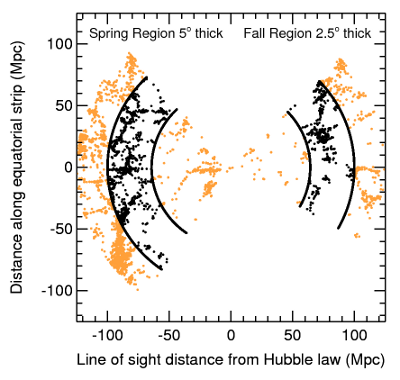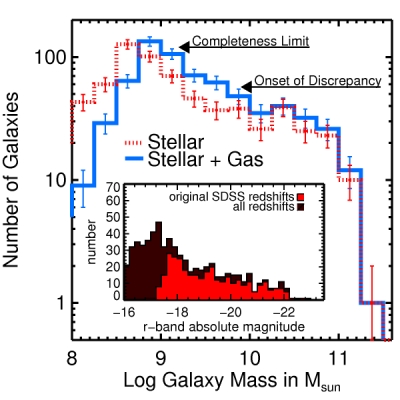REsolved Spectroscopy Of a Local VolumE
RESOLVE is a volume-limited census of stellar, gas, and dynamical mass as well as star formation and merging within >50,000 cubic Mpc of the nearby cosmic web, reaching down to the dwarf galaxy regime and up to structures on tens of Mpc scales such as filaments, walls, and voids. The survey will provide the first public database of 3D optical spectroscopy with the broad utility and discovery potential of modern imaging and redshift surveys. RESOLVE goes beyond other 3D spectroscopic surveys in four ways: (i) diverse, contiguous, and uniform local/global environment data; (ii) highly complete selection extending into the gas-dominated dwarf galaxy regime; (iii) both high-resolution ionized gas or stellar kinematic data for each galaxy and broad 320-725nm spectroscopy spanning [OII] 3727 for gas-phase metallicity analysis plus Halpha and Hbeta for disentangling emission, absorption, and extinction; and (iv) equatorial footprints enabling synergy with deep photometric surveys and unique northern and southern facilities, such as Arecibo, the GBT, and ALMA. Our science goals include creating an unprecedented multi-scale inventory of dynamically traced dark matter as well as tracking elusive difficult-to-detect gas phases by self-consistently modeling the detectable gas and stellar mass along with star formation rates and star formation histories. More generally, RESOLVE will provide a new discovery space for studies of galaxy evolution, by assembling a complete multi-purpose database connecting the detailed internal physics of galaxies with their large-scale cosmic environments. See our outreach page for a non-technical description.
The Environmental COntext (ECO) catalog around RESOLVE is a much larger, purely archival data set with pipelines and methods matched to RESOLVE, enabling statistically robust analyses of environmental trends and calibration of cosmic variance.
Survey Selection and Completeness

At right, the RESOLVE Survey (black points) is shown within a portion of the larger SDSS Redshift Survey from which it was drawn (orange points). RESOLVE comprises ~1600 galaxies in two equatorial strips (RA 22-3 hr, Dec -1.25 to +1.25 and RA 8.75-15.75, Dec 0 to +5) at redshifts cz=4500-7000 km/s. This redshift range is distant enough to avoid local peculiar flows that compromise environment analysis, close enough to permit resolution of a few hundred pc, and large enough to define a sample that can be binned by both mass and environment. The A-semester strip is also centered on a massive cluster finger-of-God. RESOLVE's equatorial footprints, especially the B-semester "Stripe 82" region, enjoy some of the deepest multi-wavelength archival imaging in the sky, including SDSS, UKIDSS, GALEX MIS, ALFALFA, Herschel, VLA continuum, and future DES and SpIES coverage. See our data page for information on how RESOLVE is adding to this treasury.

Volume-limited selection employing a floor in mass or luminosity has three key advantages: it strongly minimizes selection bias, it facilitates identification of structure in the cosmic web, and it emphasizes the low-mass galaxy population, which is key to understanding the physics of cosmic gas and dark matter. RESOLVE was initially selected down to SDSS Mr=-17.23, corresponding to the apparent magnitude limit of the SDSS redshift survey at the far side of the RESOLVE cz range. The r band is ideal for selection on the sum of stellar+cold gas mass (Kannappan & Wei 2008), yielding an approximate survey mass limit of ~109 Msun. This limit is comfortably below the scale where gas-dominated galaxies become abundant (~1010 Msun). The appearance of gas-dominated galaxies below this "gas richness threshold scale" causes the stellar mass function to fall below the baryonic mass function, as shown at right for the Stripe 82 subregion of RESOLVE. We are now working to redefine RESOLVE to be more robustly mass-limited and complete by building on the SDSS redshift survey (inset).
Goals and Progress
The high-resolution spectroscopy phase of the survey is underway, with some observing modes still under development. We have prioritized spectroscopic observations in the two regions where our HI and redshift database completion efforts are most advanced, which will facilitate an Early Science data release currently targeted for early 2016. Photometry and environment metrics for ECO and RESOLVE are already available; see "data" page. The short-term science goals of RESOLVE aim to address key challenges to make our long-term goals possible. For example:
• Recovering galaxies that meet our survey criteria but originally had either omitted or mismeasured SDSS redshifts -- crucial for robust, complete characterization of environments and mass functions as well as merger and interaction rates
• Developing direct and indirect estimators of galaxy molecular and atomic gas content -- key to constructing a complete detectable gas inventory and thus understanding undetectable gas phases
• Establishing empirical best practices for assigning single velocity measures to S0 galaxies as mixed rotation+dispersion systems -- essential for studies of the velocity function (or dynamical mass function)
• Constructing a larger "context survey" encompassing RESOLVE with homogeneous environment metrics and stellar/gas mass measurements -- important for analysis of cosmic variance in large-scale structure (see ECO page).